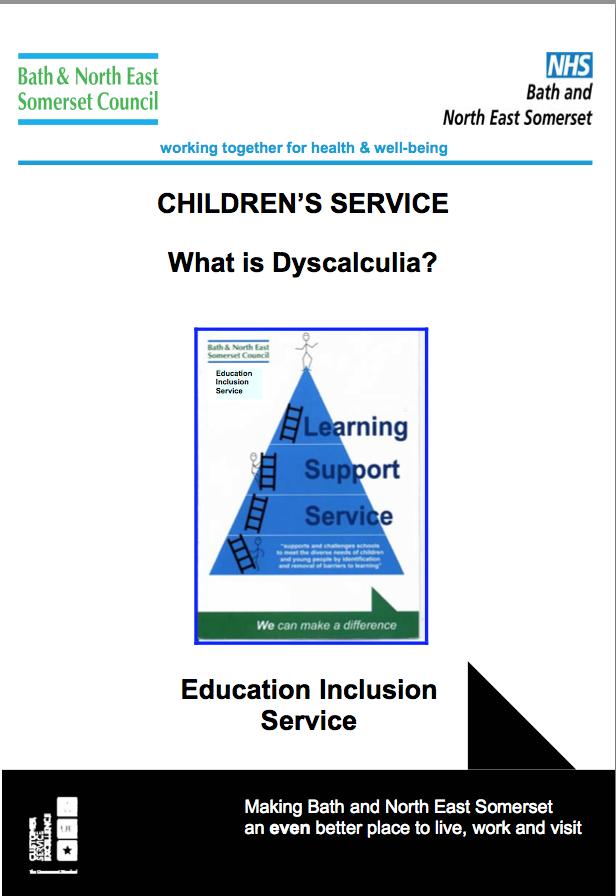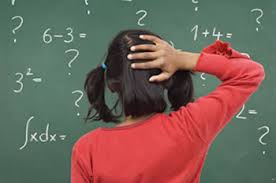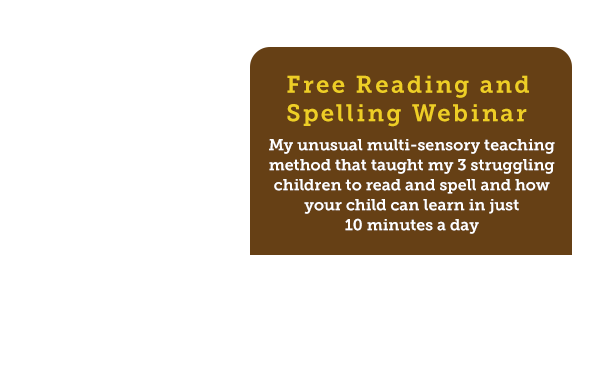DYSCALCULIA – Explained simply
Every once in a while a really great brochure comes along that is easy to read and is really useful for parents and teachers. This is one of those. I was given a copy of this brochure by a colleague Ann Williams who is studying dyscalculia for her masters degree. Thanks must go to Bath and North East Somerset Council and Learning Support Services at Three Ways School. I wonder if they realise that people all around the world use their wonderful brochure.

Ref: DfES 0512/2001
What are the difficulties in maths?
- an inability to subitise (see without counting) even very small quantities
- an inability to estimate whether a numerical answer is reasonable
- weaknesses in both short-term and long-term memory
- an inability to count backwards reliably
- directional confusion
- trouble with sequencing
- a problem with money
- delay in learning to tell the time from a clock face
- an inability to manage time in their daily lives
- confusing signs; + x ÷ –
- reliance on ‘counting on’ strategies using fingers rather than efficient methods of calculation
- difficulty with x tables – able to learn them but forgets overnight
- inability to tell which of two numbers is larger
- finds it difficult to write numbers which have zeros in them e.g. 3008
Ronit Bird (2007): The Dyscalculia Toolkit.
Steve Chinn: ‘Signs of dyscalculia’ handout.
Patoss, Corsham. 26.06.2010.
Sarah Wedderburn: Unicornmaths website.
Identification and Assessment
Checklist for identifying Pupils with Specific Learning Difficulties in Maths
taken from: ‘Dyscalculia and Specific difficulties in Mathematics – Guidance Document’.www.six.somerset.gov.uk/eis/view
Use this checklist to identify areas of difficulty and how it has been observed.
‘Evidence by’ key:
CO Classroom Observation
WS Work Sampling
IDA Individual Diagnostic Assessment
| Impact on Life Skills | Evidence by |
| High level of anxiety around maths | |
| Lacks confidence in working with number | |
| Left/Right confusion | |
| A problem with all aspects of money | |
| A marked delay in learning to read a clock to tell the time | |
| An inability to manage time in their daily lives | |
| Slow processing speeds when engaged in math activities | |
| A tendency not to notice patterns in number | |
| Inability to master timetables and manage time in their daily lives | |
| Difficulty in remembering to work in the same unit of measure within a question | |
| Impact on Self Esteem | |
| Finds it difficult to ask questions even when he or she does not understand | |
| Slow in working in comparison with others | |
| Lacks confidence in their own answers | |
| May adopt avoidance/learned helplessness strategies | |
| Dislikes whole grupe interactive sessions | |
| Number | |
| Difficulties with mental calculation | |
| Uses fingers to count simple totals | |
| Inability to subitise (see without counting) even very small quantities | |
| Inability to estimate whether a numberical answer is reasonable | |
| Needs to continue to use concrete materials as is unable to work in the abstract | |
| Finds it difficult to count on | |
| Difficulty copying numbers accurately (reverses or invert digits) | |
| Difficulty with place value ( misreads numbers 36/63) | |
| Inability to count backwards reliably | |
| Language of Maths | |
| Finds it difficult to explain mathematical processes | |
| Has problems choosing the right strategy to unpick a work problem | |
| Has sound technical reading skills but failes to understand the mathematical language | |
| Difficult to generalise learning from one situation to another | |
| Makes mistakes interpreting a word problem | |
| Confuses mathematical terms e.g. total, sum, equals | |
| Memory Difficulties | |
| Finds it difficult to learn and retain basic number facts – including times tables | |
| Finds it difficult to learn and retain what basic math symbols mean, including Maths rules, formulae and abbreviations | |
| Loses track of the ‘sum’ when completing a longer word problem | |
| Forgets previously mastered procedures | |
| Difficulties with Sequencing | |
| Has difficulty sequencing the order and the value of numbers | |
| Loses place/track when counting | |
| Difficulty reciting the times tables | |
| Difficulties with position, spatial organisation and visujal perception | |
| Confuses numbers and uses them interchangeably e.g. 12 and 21 | |
| Confuses basic symbols e.g. + and x | |
| Poor setting out of work and calculations on the page often resulting in errors | |
| Does not see the difference between 6-4 and 4-6 | |
| Takes the smaller number form the larger regardless of position | |
| Finds estimating and rounding numbers difficult | |
| Finds telling the time on an analogue clock difficult and may have poor understanding relating to the passage of time | |
| Is easily distracted/overloaded by worksheets full of maths | |
| Copies inaccurately | |
| Confuses the axes on graphs and co-ordinates |


















